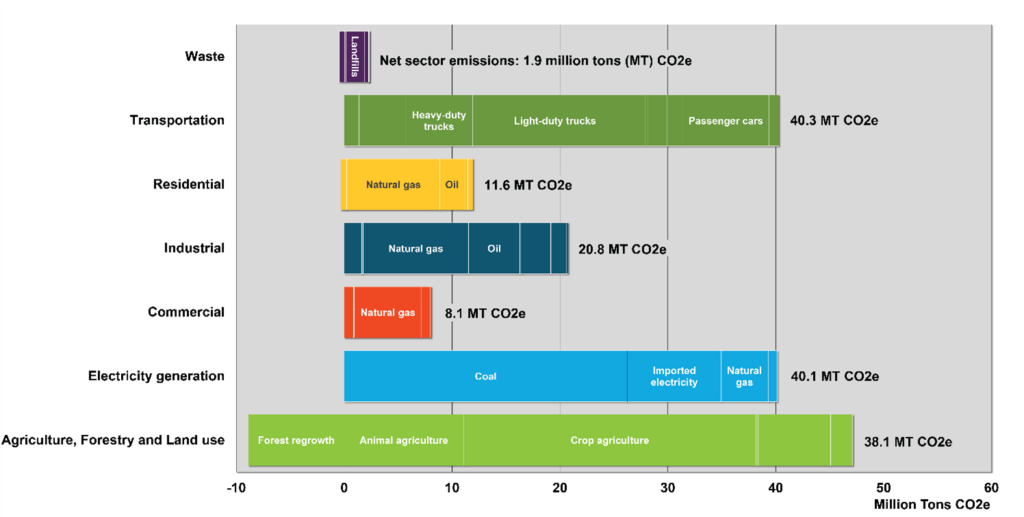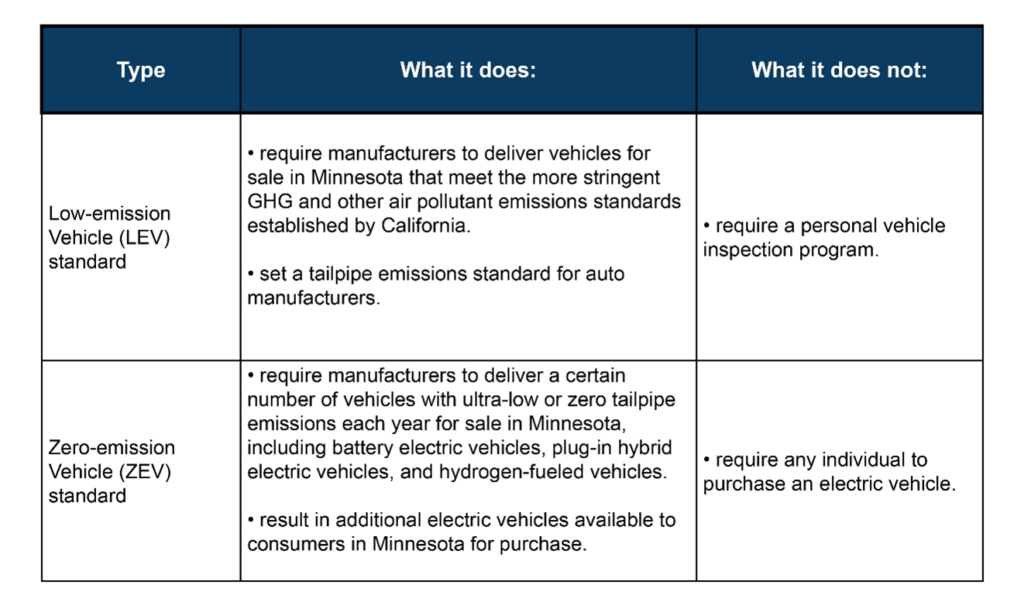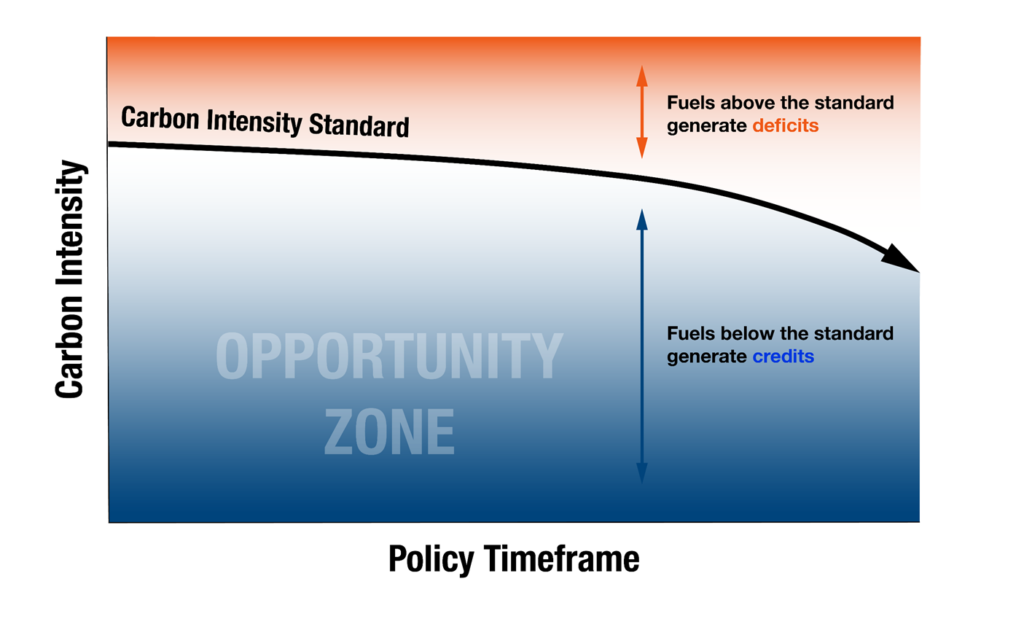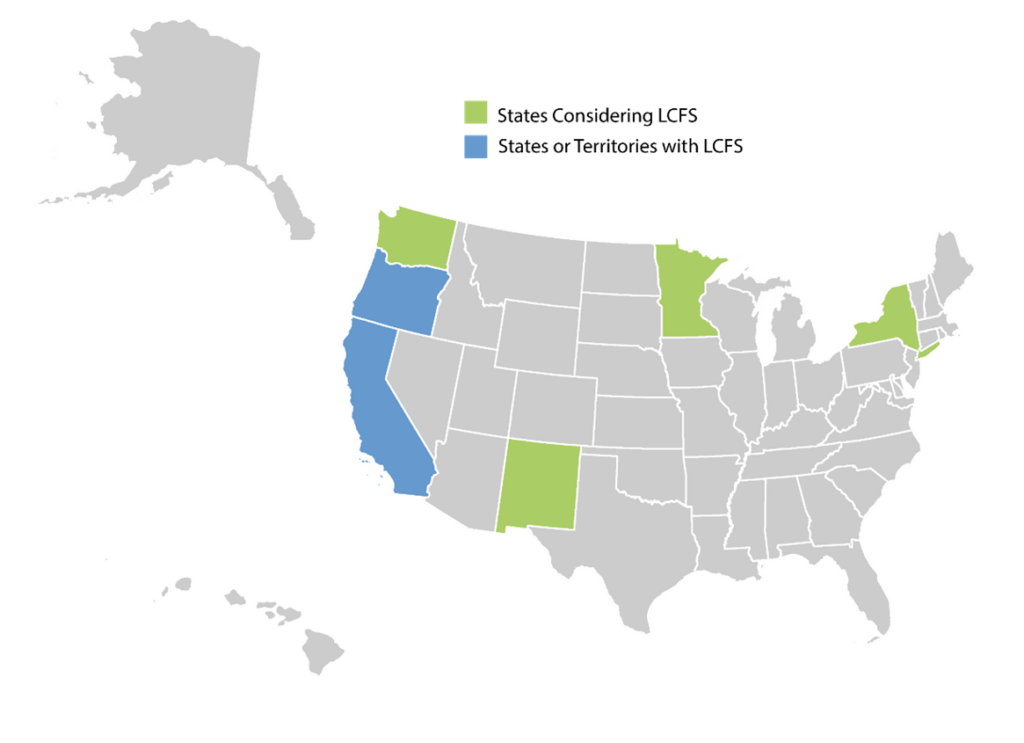Transportation and Fuel Policy Options in Minnesota: Clean Cars Minnesota, Future Fuels Act, and More
May 19, 2021 | Katelyn Bocklund and Jessi Wyatt | Education

The following blog was originally published on Great Plains Institute’s website. Both policies explored in this blog could help increase electric vehicle adoption in Minnesota. For more information on how a clean fuels policy could benefit electric vehicles, refer to our formerly published blog on the subject.
The transportation sector is the highest emitting sector of greenhouse gases (GHG) in Minnesota. This post summarizes two of the major transportation policies currently being developed in Minnesota to address the state’s GHG emissions—Clean Cars Minnesota and the Future Fuels Act.
Key takeaways:
- Transportation sector emissions reductions are critical to help meet Minnesota’s economywide emissions reduction goals set by the state’s Next Generation Energy Act.
- The Future Fuels Act and Clean Cars Minnesota are distinct but not mutually exclusive policies.
- Clean Cars Minnesota is a rulemaking overseen by the Minnesota Pollution Control Agency.
- The Future Fuels Act is a proposed policy to investigate and consider a regional market-based program to help incentivize low-carbon fuel deployment.
Transportation sector emissions reduction targets in Minnesota
Transportation has been the highest emitting sector in Minnesota since 2016, growing to a quarter of statewide emissions in 2018 (the most recent year reported). Electric sector emissions declined during this period while transportation-related emissions stayed relatively constant.
Minnesota’s Next Generation Energy Act outlined emissions reduction targets (from 2005 levels) over time:
- 15 percent by 2015
- 30 percent by 2025
- 80 percent by 2050
Through 2018, transportation emissions have only declined by 7 percent. Meeting these reduction targets will not be possible without new, innovative policy interventions that can address emissions across the transportation sector.
Figure 1. Minnesota greenhouse gas (GHG) emissions by sector for 2018

Figure authored by Jessi Wyatt, Great Plains Institute, 2021, shows emissions from 2018 for each sector. Data Source: “Greenhouse gas emissions data,” Minnesota Pollution Control Agency, https://www.pca.state.mn.us/air/greenhouse-gas-emissions-data
Key highlights of Clean Cars Minnesota and the Future Fuels Act
Clean Cars Minnesota and the Future Fuels Act are two distinct but not mutually exclusive policies that aim to reduce GHG emissions in the transportation sector:
- Clean Cars Minnesota is a rulemaking overseen by the Minnesota Pollution Control Agency that aims to increase the availability of low- and zero-emission vehicles in the state.
- The Future Fuels Act is a legislative bill that proposes a market-based program to reduce the amount of high carbon transportation fuels in use. It was introduced at the Minnesota legislature on March 10, 2021. Unlike Clean Cars MN, the Future Fuels Act is a bill in the legislature. If adopted into statute, it would direct rulemaking by a state agency.
There are many other policy options, and multiple solutions are necessary to achieve sufficient GHG emission reductions in the transportation sector.
Table 1. Summary of Clean Cars MN and Future Fuels Act

Transportation Policy and Air Quality: US Policy
The Clean Air Act allows the US Environmental Protection Agency (EPA) to set standards for air pollution from cars but prevents states from creating their own standards. Since California had vehicle emissions standards prior to the Clean Air Act, the state was allowed to get a waiver from the EPA to adopt its own, more stringent standards.
Because California is granted special permissions under the Clean Air Act to set vehicle emissions standards stricter than the federal government’s, there are two active regulatory standards in place in the country.
State standards
- States that want to adopt stricter standards than the federal standards can do so under section 177 of the Clean Air Act by adopting the standards developed by California.
- However, to adopt these more stringent standards, states must adopt California’s standards exactly and avoid creating any requirements different from those established by California.
Federal standards
- At the federal level, the US Department of Transportation’s (DOT) National Highway Traffic and Safety Administration (NHTSA) regulates vehicle fuel efficiency standards in the US under the Corporate Average Fuel Economy (CAFE) Standards. The CAFE Standards set fleet-wide fuel-efficiency averages that must be achieved by each automaker for its car and truck fleet each year, with requirements for improvements in vehicle fuel efficiency by a specific year.
- In 2009, as a result of the Endangerment Finding, the EPA began regulating GHG emissions under the Clean Air Act.
- In 2010, NHTSA and EPA issued joint Final Rules for Corporate Average Fuel Economy and Greenhouse Gas emissions regulations for light-duty vehicles.
- The CAFE and GHG emissions standards were weakened during the prior administration in 2020.
What is Clean Cars Minnesota?
The Minnesota Pollution Control Agency (MPCA) is working through the rulemaking process to enact the California standards in Minnesota. Adoption will require vehicle manufacturers to deliver vehicles to the Minnesota market that produce lower emissions of GHG and other air pollutants than the comparative federal standards.
The MPCA, using existing statutory authority to regulate air pollution from vehicles, can adopt the low emission vehicle (LEV) standard, the zero-emission vehicle (ZEV) standard, both the LEV standard AND the ZEV standard, or neither.
Table 2. Summary of LEV and ZEV standards

Since the Clean Air Act requires states that would like to adopt alternative standards do so verbatim to the existing California standards, Minnesota has no flexibility within the rules to adopt Minnesota-specific changes. The one area where Minnesota would have some limited flexibility is in how the state establishes initial ZEV credit banks for manufacturers.
As of 2020, 14 states and the District of Columbia have adopted LEV/ZEV standards.
Table 3. Summary of of states with LEV/ZEV standards adopted
| State | Legislation or Regulation | Year Adopted | Year Active |
| California | AB 1493 | 2002 | 2005 |
| New Jersey | P.L. 2003, Chapter 266 | 2004 | 2009 |
| Connecticut | Public Act 04-84 | 2004 | 2008 |
| Washington | House Bill 1397 | 2005 | 2009 |
| Vermont | Amendments to Subchapter XI | 2005 | 2009 |
| New York | Chapter III, Subpart 218-8 | 2005 | 2009 |
| Maine | Amendments to Chapter 127 | 2005 | 2009 |
| Rhode Island | Air Pollution Control Regulation No. 37 | 2005 | 2009 |
| Massachusetts | Amendments to the state’s LEV regulations | 2005 | 2009 |
| Oregon | Regulations (Division 257; OAR 340-256-0220) | 2006 | 2009 |
| Pennsylvania | Amendments to Title 25, Chapters 121 and 126 | 2006 | 2008 |
| Maryland | Senate Bill 103 | 2007 | 2011 |
| Washington D.C | Act 17-323 | 2008 | 2012 |
| Delaware | Regulation 1140 | 2010 | 2014 |
| Colorado | Regulation Number 20 | 2018 (LEV) 2019 (ZEV) | 2022 |
Source: This table was adapted from the state of Maryland summary of states adopting California’s Clean Car Standards, available on their website at https://mde.maryland.gov/programs/air/mobilesources/pages/states.aspx, updated as of 2021.
Where is Minnesota in the Clean Cars Minnesota rulemaking process?
The Minnesota Pollution Control Agency (MPCA) originally published a legal notice of its intent to begin a new rulemaking in October 2019. After publishing the intent, the MPCA hosted numerous public and technical meetings, information sessions, and sought comments as part of the rulemaking process. On May 7, 2021, Administrative Law Judge Palmer-Denig issued a rule stating that the MPCA can move forward with adopting the rule.
More information is available on the MPCA website, including recordings of past webinars, public, and technical meetings.
The Minnesota Pollution Control Agency (MPCA) oversees the rulemaking process for Clean Cars MN, and questions should be directed to MPCA staff at [email protected].
What is the Future Fuels Act?
The Future Fuels Act is a clean fuels policy being explored in Minnesota and was introduced as legislation on March 10. It followed recommendations to pursue a clean fuels policy, or low carbon fuel standard, by the Governor’s Council on Biofuels and Sustainable Transportation Advisory Council.
Modeled after similar policies in California and Oregon, it is a proposed market-based policy that would reduce the amount of higher-carbon transportation fuels by increasing the production and use of lower-carbon fuels. It would create opportunities for low-carbon fuels to participate in a fuel market by
- Setting a standard for reduced carbon intensity of fuels over time, and
- Establishing incentives for fuel producers to lower their carbon intensity through production process efficiency improvements, switching to lower-carbon fuel or feedstocks, and decarbonizing the fuel and feedstock supply chain.
A well-implemented clean fuels policy results in less use of higher-carbon fuels and more useof lower-carbon fuels, including ethanol, electricity, biomethane, and others.
How does the proposed clean fuels policy work?
- High-carbon fuel producers are required to supply steadily lower-carbon intensity fuels over time and can determine how to meet the standard on their own.
- Fuel producers that do not meet the annual baseline standard must purchase alternative fuel or credits.
- Fuel producers that meet or exceed the standard generate credits proportional to the difference in their carbon intensity and the standard.
Figure 2. Mechanics of clean fuels market

What a clean fuels policy is not
A clean fuels policy is different than other approaches to supporting clean fuel and clean transportation innovation. A few things that it is not:
- It does not create any connection with California regulators, rather it preserves. state independence in policymaking and regulation.
- It is not a tax and does not involve the government collecting any tax revenue.
- It is not a mandate and does not pick technology winners and losers.
Where have clean fuels or similar policies already been adopted?
- The European Union was among the first to adopt a low carbon fuel standard (LCFS), which took effect in 2018.
- California adopted an LCFS which took effect in 2011 and was re-adopted in 2015.
- Oregon adopted a Clean Fuels Program—a version of the LCFS that shared the same essential structure as California’s—in 2009.
- British Columbia adopted an LCFS in 2010 as part of its Renewable and Low Carbon Fuel Requirements Regulation.
- Brazil passed an LCFS in June 2019. Canada is working on a national Clean Fuel Standard.
- Canada currently has a federal Renewable Fuels Regulation in place that has no carbon emission reduction goals.
- Washington State (and Puget Sound) and New York have both brought legislation to the state legislature but has not yet passed.
Figure 3. Low carbon fuel standards (LCFS) in the United States

Where is Minnesota in the clean fuels policy process?
The Future Fuels Act, a bicameral and bipartisan bill, was introduced to the Minnesota legislature on March 10 (House version, Senate version) and received its first hearing on March 11. Chief bill authors are Minnesota House of Representatives Assistant Majority Leader Todd Lippert (DFL) and Senate Energy and Utilities Finance and Policy Committee Chairman David Senjem (R). It is supported by the Minnesota Future Fuels Coalition, which is facilitated by the Great Plains Institute, and incorporates a set of principles outlined by the coalition.
Before the legislation can become law, it will need to successfully pass through the House and Senate and be signed into law by Governor Walz. After being signed into law with appropriate legislative oversights in place, it would be directed to the Minnesota Department of Commerce to oversee the rulemaking process.
Conclusion
At all scales—local communities, states, regions, and nationally—we are seeking solutions to address transportation sector emissions, and there is a broad suite of policy options to consider. In Minnesota, Clean Cars Minnesota and the Future Fuels Act are two distinct policies aiming to meet GHG goals. At the end of the day, one thing is clear—we cannot reduce transportation emissions to where they need to be without policy solutions and opportunities.Follow along with breaking developments on transportation policy solutions by subscribing to the Great Plains Institute e-newsletter and reading more about our Transportation & Fuels work.
